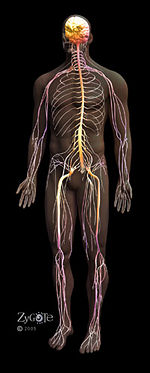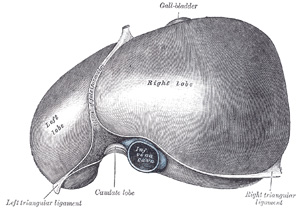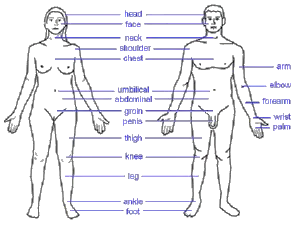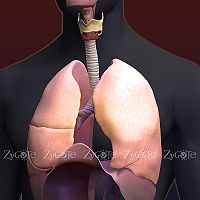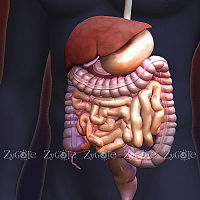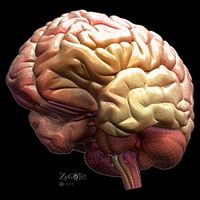Difference between revisions of "Human body" - New World Encyclopedia
Rick Swarts (talk | contribs) |
Rick Swarts (talk | contribs) |
||
| Line 58: | Line 58: | ||
*[[Digestive system]]. The digestive system, noted above, breaks down food into molecules that the body can use. The alimentary canal, or digestive tract, begins at the mouth and winds through the esophagus, stomach, small intestine, and large intestine, until the anus. The digestive system also includes the liver, located near the stomach in the abdominal cavity, which is vital for digesting fats by secreting bile, an emulsifying agent that breaks down fat globules into small droplets. The gallbladder stores and concentrates the bile. The pancreas, also part of the digestive system, secretes pancreatic fluid, that have digestive enzymes for breaking down nutrients. | *[[Digestive system]]. The digestive system, noted above, breaks down food into molecules that the body can use. The alimentary canal, or digestive tract, begins at the mouth and winds through the esophagus, stomach, small intestine, and large intestine, until the anus. The digestive system also includes the liver, located near the stomach in the abdominal cavity, which is vital for digesting fats by secreting bile, an emulsifying agent that breaks down fat globules into small droplets. The gallbladder stores and concentrates the bile. The pancreas, also part of the digestive system, secretes pancreatic fluid, that have digestive enzymes for breaking down nutrients. | ||
| − | *[[Endocrine system]]. The endocrine system is a control system that transmits chemical messages within the body using hormones, which are chemicals that are produced in one part of the body to impact cells in another part of the body. Major endocrine glands include the pineal gland, pituitary gland, thyroid gland, thymus, adrenal gland, pancreas, and gonads (the ovary in females, and testis in males). | + | *[[Endocrine system]]. The endocrine system is a control system that transmits chemical messages within the body using hormones, which are chemicals that are produced in one part of the body to impact cells in another part of the body. Major endocrine glands include the pineal gland, pituitary gland, thyroid gland, thymus, adrenal gland, pancreas, and gonads (the ovary in females, and testis in males). There are also endocrine tissues in such organs as the brain, kidneys, stomach, and pancreas that produce hormones. |
| + | |||
| + | *[[Immune system]]. The immune system involves organs and specialized cells that protect the body against pathogens, such as bacteria and viral infections. This system includes barriers to infection, such as skin and mucus coating of the gut and airways, phagocytic cells that can ingest and digest foreign substances, and anti-microbrial proteins. The stomach also secretes gastric acid, that helps to prevent bacterial colonization, and an adaptive immune system response helps to develop immunity to being infected twice by the same pathogen. | ||
| + | |||
| + | *[[Integumentary system]]. The integumentary system includes the skin, hair, nails, and skin glands and their products. This system helps in sensing the person's surrounding, retention of body fluids, body temperature regulation, elimination of waste products, and offering a protective barrier from the environment outside the body. | ||
| + | |||
| + | *[[Muscular system]]. The muscles, which are attached to the skeletal frame, causes the body to move. | ||
| + | |||
| + | *[[Skeletal system]]: The skeletal system or skeleton provides structural support and protection through bones. There are two basic parts, the axial skeleton (spine, ribs, sacrum, sternum, cranium, and about 80 bones in all) and the appendicular skeleton (bones of arms, pelvis, legs, and shoulders, and 126 bones in all). While at birth a human has about 350 bones, the adult body has about 206 bones, due to the fusing of some of the bones. | ||
| + | |||
| + | *[[Lymphatic system]]. The lymphatic system collects the blood plasma lost from the circulatory system as lymph and returns it to the circulatory system. | ||
| + | |||
| + | *[[Nervous system]]. The nervous system functios in collecting, transferring and processing information via cellular communication involving nerve cells. | ||
| + | |||
| − | |||
| − | |||
| − | |||
| − | |||
| − | |||
| − | |||
*[[Reproductive system]]: the sex organs | *[[Reproductive system]]: the sex organs | ||
*[[Respiratory system]]: the organs used for breathing, the lungs | *[[Respiratory system]]: the organs used for breathing, the lungs | ||
| − | *[[ | + | *[[Urinary system]]. The excretory system is involved in removing the metabolic waste products of cellular activity, such as |
| + | |||
| + | eliminating wastes from the body | ||
==External features== | ==External features== | ||
Revision as of 20:31, 24 February 2006
As commonly defined, the human body is the physical matter of a human being, including the chemical elements, cells, and extracellular materials and the organization of these materials into tissues, organs, and systems. The human body, like the bodies of all animals, is made up of systems, that are made up of organs, that are made up of tissues, that are made up of cells.
Several fields are involved in the study of the human body. Human anatomy or anthropotomy is a specialized field within anatomy that is focused on the structure and form of the human body, such as the description of organs and organ systems Human physiology is a specialized field within physiology that encompasses the study of the functioning of the human body, including systems, tissues, and cells. Thus, physiology tends to be more dynamic, and concerned with functioning, while anatomy is more descriptive of structure. The study of tissues is the focus of histology and the study of cells is part of cytology.
Since human beings define themselves not just in biological terms, but also in social, spiritual, and religous terms, it is natural that the term "human body" can take on broader meanings than defined above. In some religions, for example, there is a concept that humans have not only a physical body, but also a "spiritual body," which may mirror the appearance of the physical body, but that also exists after the death of the physical body. An example of such is found in the Bible: "??? spiritual body".
In addition, the concept of human body is often used in context of "mind-body unity" or "mind-body" disunity, in order to convey a separation between physical and spiritual desires, or as reflected in philosophy, the "mind-body problem."
(look up the ICUS book on mind/brain, etc.)
Add the great deal of complexity — repairs itself, and so forth.
Chemical elements
The most common chemical elements in the human body are oxygen (65% by mass), carbon (18%), hydrogen (10%), and nitrogen (3%), calcium (1.5%) and phosphorus (1.0%). These six elements make up 99% of the mass of the human body. Potassium (0.35%), sulfur (0.25%), sodium (0.15%) and magnesium ().05%) are the next four most common elements. Ten elements only combine for about 0.7% of the human body's mass: iron, , copper, zinc, selenium, molybedenum, fluorine, chlorine, iodine, manganese, and cobalt. Trace elements that have been identified include lithium, strontium, aluminum, silicon, lead, vanadium, arsenic, and bromine.
The most common compound in the human body is water, with cells having between 65% and 90% by weight. Four other common compounds are carbohydrates (such as glucose or starch), lipids (fats), nucleic acids, and proteins. These lst four all include the element carbon.
Cells
The average adult human body is estimated to have ten trillion cells. These range in size from a sperm cell, which is the smallest, to the egg cell, which is the largest. The sperm head is about 2.5 to 3.5 microns wide and 5 to 7 microns long, with a tail about 50 to 80 microns long. The egg cell is about 60 microns in diameter. In reality, muscle cells are larger because they are multinuclear and represent the fusion of many individual cells, and nerve cells are lage because of the axons, but the actual cell body is smaller than the egg.
There are a wide variety of types of cells, and they differ in size, shape and function. among the types of cells are bone cells, blood cells, nerve cells, muscle cells, stomach cells, etc. Red blood cells carry oxygen, bone sells form the skeleton of the body, nerve cells carry electrical signals, and muscle cells move the bones. Stomach cells secrete acids to digest food, and cells in the intestines absorb nutrients.
Tissues
Tissues are collections of similar cells that perform a specialized function. The human body has four primary tissue types:
- Muscle tissue. Muscle tissue makes up the muscles of the body. There are approximately 650 skeletal muscles in the human body. Muscle tissue has the ability to contract. There are three general types of muscle: smooth muscle (or "involuntary muscle"), such as foundin the intestine and throat, cardiac muscle, an involuntary muscle found only in the heart; and skeletal muscle, a voluntary muscle anchored by tendons to bones and used for skeletal movement. Muscle tissue is composed of muscle cells. All three types of muscle use actin and myosin to produce contraction and relaxation, and thus movement. Exercize does not increase muscles, but rather the size of the muscle cells.
- Nerve tissue. Nerve tissue is composed of two cell types: neurons and glial cells. Neurons have excitable membranes that allow them to generate and transmit electrical signals. They are found in the peripheral nervous system, the spinal cord, and the brain. Glial cells are non-neuronal cells that for myelin, provide support and nutrition, and assist in the signal transmssion. The human brain is estimated to have 50 times as many glial cells as neurons.
- Epithelial tissue. Epithelial tissue is composed of tightly packed cells that form continuous sheets and serve as linings for different parts of the body. Epithelial tissues line organs, helping to keep them protected and separate. Epithelial tissue lines the outside of the body (skin) and inside (the mouth, stomach, intestine, lungs, reproductive and urinary tract, endocrine glands, exocrine glands, etc.).
- Connective tissue. Connective tissue is composed of a variety of types of cells and generally provides support, protection, and structure to the human body. Examples include cartilage, tendons, inner layers of skin, ligaments, lymph, and fat tissue. Blood is also considered a connective tissue. Connective tissues are surrounded by, or embedded in, a matrix, that can be solid, semisolid, or even liquid. Bone contains specialized cells (osteocytes) within a mineralized extracellular matrix, and functions in support as connective tissue. Blood is surrounded by a liquid matrix, and fat cells by a semisolid matrix. Fibrous strands of the protein collagen often provide strength to connective tissue.
Organs
An organ is a group of two or more different kinds of tissues that work together to perform a specific function or group of fuctions. Examples of organs include the heart, lungs, brain, eye, stomach, spleen, pancreas, kidneys, liver, intestines, uterus, bladder, bone, and so forth.
The largest organ in the human body is the skin. Covering the entire body, even the eyes, which have a transparent layer of skin called the conjunctiva, the skin offers protection from water, air, sunlight, injury, dirt, chemicals, and microorganisms. The skin also helps to regulate temperature; contains nerves for sensation to touch and termperature; and holds fluids inside the body. Made up to three layers of tissue—the top epidermis, the inner dermis, and the deepest layer of subcutaneouos fatty tissue—the skin of an average adult covers an area of about 22 square feet, and varies in thickness depending on the part of the body covered. Fingernails and toenails are composed of dead cells from the epidermis, and hair is also modified epidermis.
The largest organ inside the human body is the liver. The liver in an adult typically weighs between 1.0 and 2.5 kilograms. The liver plays a major role in metabolism and has a number of functions in the body including drug detoxification, glycogen storage, and plasma protein synthesis. It also produces bile, which is important for digestion.
Major systems of the human body
A group of organs functioning as a unit is called a system, or organ system. For example, the the stomach, small intestine, liver and pancreas are part of the digestive system, and the kidneys, bladder, and connecting tubes constitute the urinary system.
The following are the major systems of the human body.
- Cardiovascular system. The cardiovascular system, or circulatory system, is an organ system that move substances to and from cells, such as transporting oxygen, nutrients, and waste materials. The human ccirculatory system consists of the heart, a network of blood vessels, and blood.
- Digestive system. The digestive system, noted above, breaks down food into molecules that the body can use. The alimentary canal, or digestive tract, begins at the mouth and winds through the esophagus, stomach, small intestine, and large intestine, until the anus. The digestive system also includes the liver, located near the stomach in the abdominal cavity, which is vital for digesting fats by secreting bile, an emulsifying agent that breaks down fat globules into small droplets. The gallbladder stores and concentrates the bile. The pancreas, also part of the digestive system, secretes pancreatic fluid, that have digestive enzymes for breaking down nutrients.
- Endocrine system. The endocrine system is a control system that transmits chemical messages within the body using hormones, which are chemicals that are produced in one part of the body to impact cells in another part of the body. Major endocrine glands include the pineal gland, pituitary gland, thyroid gland, thymus, adrenal gland, pancreas, and gonads (the ovary in females, and testis in males). There are also endocrine tissues in such organs as the brain, kidneys, stomach, and pancreas that produce hormones.
- Immune system. The immune system involves organs and specialized cells that protect the body against pathogens, such as bacteria and viral infections. This system includes barriers to infection, such as skin and mucus coating of the gut and airways, phagocytic cells that can ingest and digest foreign substances, and anti-microbrial proteins. The stomach also secretes gastric acid, that helps to prevent bacterial colonization, and an adaptive immune system response helps to develop immunity to being infected twice by the same pathogen.
- Integumentary system. The integumentary system includes the skin, hair, nails, and skin glands and their products. This system helps in sensing the person's surrounding, retention of body fluids, body temperature regulation, elimination of waste products, and offering a protective barrier from the environment outside the body.
- Muscular system. The muscles, which are attached to the skeletal frame, causes the body to move.
- Skeletal system: The skeletal system or skeleton provides structural support and protection through bones. There are two basic parts, the axial skeleton (spine, ribs, sacrum, sternum, cranium, and about 80 bones in all) and the appendicular skeleton (bones of arms, pelvis, legs, and shoulders, and 126 bones in all). While at birth a human has about 350 bones, the adult body has about 206 bones, due to the fusing of some of the bones.
- Lymphatic system. The lymphatic system collects the blood plasma lost from the circulatory system as lymph and returns it to the circulatory system.
- Nervous system. The nervous system functios in collecting, transferring and processing information via cellular communication involving nerve cells.
- Reproductive system: the sex organs
- Respiratory system: the organs used for breathing, the lungs
- Urinary system. The excretory system is involved in removing the metabolic waste products of cellular activity, such as
eliminating wastes from the body
External features
Common names of well known parts of the human body, from top to bottom :
- Skin
- Head — Forehead — Eye — Ear — Nose — Mouth — Tongue — Teeth — Jaw — Face — Cheek — Chin
- Neck — Throat — Adam's apple — Shoulders
- Arm — Elbow — Wrist — Hand — Fingers — Thumb
- Spine — Chest — Breast — Ribcage
- Abdomen — Belly button — Sex organs (Penis/Scrotum or Clitoris/Vagina) — Rectum — Anus
- Hip — Buttocks — Leg — Thigh — Knee — Calf — Heel — Ankle — Foot — Toes
Internal organs
Common names of internal organs (in alphabetical order) :
- Adrenal glands — Appendix — Bladder — Brain — Duodenum — Gall bladder — Heart — Intestines — Kidney —Liver— Lungs — Ovaries — Pancreas — Parathyroid gland — Pituitary gland — Prostate gland — Spleen — Stomach — Thymus gland — Thyroid gland — Testicles — Womb
Anatomy of the brain
- Amygdala — Brainstem — Cerebellum — Cerebral cortex — Hypothalamus — Limbic system — medulla— midbrain — Pituitary gland — pons
- See also: Human brain, List of regions in the human brain
Studying human anatomy
Certain professions, especially medicine and physiotherapy, require the study of human anatomy in depth. Textbooks usually split the body into the following regional groups:
- Head and Neck - includes everything above the thoracic inlet
- Upper limb - includes everything from your hand, forearm, arm, shoulder, axilla, pectoral region and scapular region.
- Thorax - contains the region of the chest from the thoracic inlet to the thoracic diaphragm.
- Abdomen - everything from the thoracic diaphragm to the pelvic brim or to the pelvic inlet.
- The back - about the spine and its components, the intervetebral disks and bodies
- Pelvis and Perineum - the pelvis consists of everything from the pelvic inlet to the pelvic diaphragm. The perineum is everything below the pelvic diaphragm.
- Lower limb - the lower limb is usually everything below the inguinal ligament, including the thigh, the hip joint, the leg, and the foot.
ReferencesISBN links support NWE through referral fees
- H. A. Harper, V. W. Rodwell, P. A. Mayes, Review of Physiological Chemistry, 16th ed., Lange Medical Publications, Los Altos, California 1977.
Credits
New World Encyclopedia writers and editors rewrote and completed the Wikipedia article in accordance with New World Encyclopedia standards. This article abides by terms of the Creative Commons CC-by-sa 3.0 License (CC-by-sa), which may be used and disseminated with proper attribution. Credit is due under the terms of this license that can reference both the New World Encyclopedia contributors and the selfless volunteer contributors of the Wikimedia Foundation. To cite this article click here for a list of acceptable citing formats.The history of earlier contributions by wikipedians is accessible to researchers here:
The history of this article since it was imported to New World Encyclopedia:
Note: Some restrictions may apply to use of individual images which are separately licensed.
